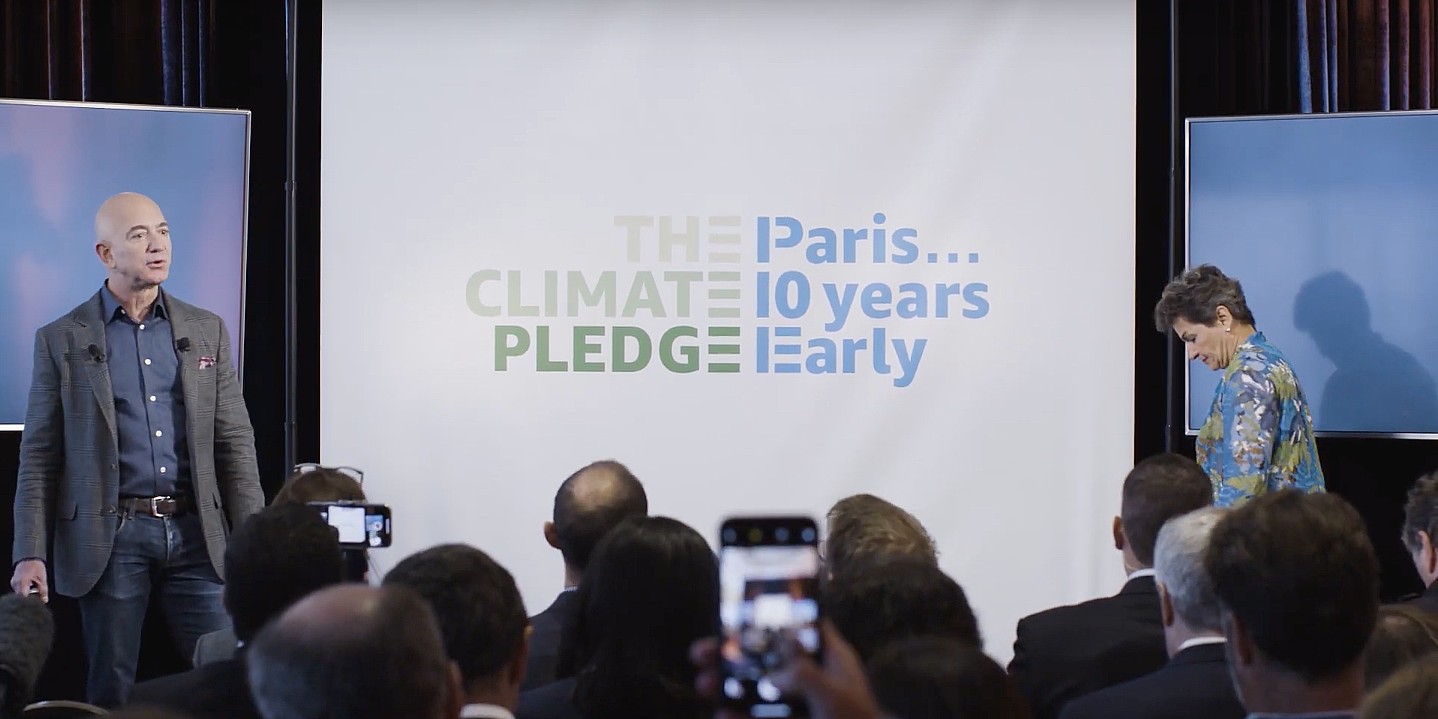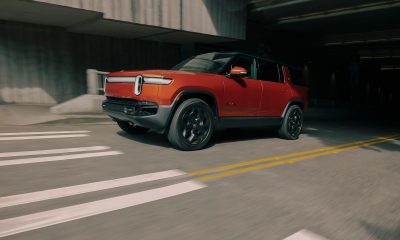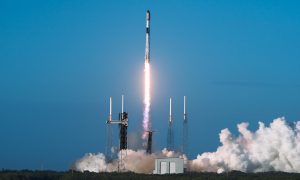

News
Amazon to help boost oil production amid Climate Pledge, Rivian van orders
Just a few weeks ago, Amazon CEO Jeff Bezos announced that his company would be purchasing 100,000 Rivian electric vans to deliver its packages, as well as provide more eco-friendly packaging. The decisions were made after employees demanded he take the necessary steps to reduce the carbon footprint the e-commerce giant was causing. Bezos complied, alleviating the possible strike that Amazon employees were poised to take part in.
It finally seemed like one of the world’s biggest companies was taking an environmental approach to its business model, but that may not entirely be the case. As revealed by a press release from Weatherford, one of the world’s leading oilfield service companies, Amazon was one of the main contributors to the U.S. Oil and Gas Industry’s “Production 4.0” forum at the Enterprise Software Conference in Houston, Texas. The forum’s theme was simple — it centers on the development of technology that can accelerate and improve oil production.
“Weatherford Production 4.0 products, including ForeSite Edge, ForeSite Platform, CygNet Platform and ForeSite Sense, activate field-wide intelligence to maximize production. Weatherford delivers the future of production performance through next-generation automation, IoT infrastructure and advanced optimization software to boost production, uptime and efficiency,” Manoj Nimbalkar, Weatherford’s Global VP of Production Automation and Software, said.
The irony of Amazon’s decision to join this conference is notable. The company, after all, previously committed to delivering its new, environmentally-conscious packages via electric vehicle just a few short weeks ago, and now is helping the oil industry thrive. The future of gas and oil will not only contribute to the global climate crisis, but it also contributes to the decision to not have large corporations take a more environmentally-aggressive approach to the operations of their businesses. The influence Amazon might have carried with its decision to rely less on fossil fuels to power its vehicles could have convinced other companies to follow in its footsteps.
Bezos gained the respect of many eco-friendly groups when he announced his partnership with Rivian. The CEO invested $700M into the electric automaker in February 2019, making the impression that he and his company would begin gearing up for a future that would not include operating on fossil fuels. But when the company began its “Climate Pledge” in mid-September at the National Press Club, details were vague. Bezos was nevertheless adamant about doing his part to help reach the specifics of the Paris Agreement, and even took an aggressive line by stating that he wanted to accomplish the goals 10 years early. Despite the fact that the US will pull out of the agreement on behalf of President Donald Trump later this year, Amazon, at least at the time, have the impression that it was doing its part to contribute to environmental sustainability.
But unfortunately, the old saying “actions speak louder than words” is all too true here. All while Bezos and Amazon were taking the necessary steps to reduce its carbon footprint and become a company that will help the planet, it appears that they were putting an effort to help advance oil and gas companies just the same. It appears they have taken two steps forward and three steps back with this news. After all, when Bezos was asked at the National Press Club meeting in Washington, D.C. if he would sever ties with oil companies that Amazon supports, he gave a firm “No.”
Ten-thousand Rivian vans boasting the Amazon logo are due to hit the road and begin delivering packages in 2021, and the remaining 90,000 will be ready before 2030. It also intends to utilize Earth-friendly packaging materials, apart of the “Shipment Zero” plan, by the end of 2019. But the announcement of Amazon’s participation seems to somewhat derail, or at least delay, any ideas that the company was interested in becoming a sustainable company. After promising employees that it would begin an effort to become “green”, is Amazon really sincere in its efforts to help the climate after all?
News
Tesla launches in India with Model Y, showing pricing will be biggest challenge
Tesla finally got its Model Y launched in India, but it will surely come at a price for consumers.

Tesla has officially launched in India following years of delays, as it brought its Model Y to the market for the first time on Tuesday.
However, the launch showed that pricing is going to be its biggest challenge. The all-electric Model Y is priced significantly higher than in other major markets in which Tesla operates.
On Tuesday, Tesla’s Model Y went up for sale for 59,89,000 rupees for the Rear-Wheel Drive configuration, while the Long Range Rear-Wheel Drive was priced at 67,89,000.
This equates to $69,686 for the RWD and $78,994 for the Long Range RWD, a substantial markup compared to what these cars sell for in the United States.
🚨 Here’s the difference in price for the Tesla Model Y in the U.S. compared to India.
🚨 59,89,000 is $69,686
🚨 67,89,000 is $78,994 pic.twitter.com/7EUzyWLcED— TESLARATI (@Teslarati) July 15, 2025
Deliveries are currently scheduled for the third quarter, and it will be interesting to see how many units they can sell in the market at this price point.
The price includes tariffs and additional fees that are applied by the Indian government, which has aimed to work with foreign automakers to come to terms on lower duties that increase vehicle cost.
Tesla Model Y seen testing under wraps in India ahead of launch
There is a chance that these duties will be removed, which would create a more stable and affordable pricing model for Tesla in the future. President Trump and Indian Prime Minister Narendra Modi continue to iron out those details.
Maharashtra Chief Minister Devendra Fadnavis said to reporters outside the company’s new outlet in the region (via Reuters):
“In the future, we wish to see R&D and manufacturing done in India, and I am sure at an appropriate stage, Tesla will think about it.”
It appears to be eerily similar to the same “game of chicken” Tesla played with Indian government officials for the past few years. Tesla has always wanted to enter India, but was unable to do so due to these import duties.
India wanted Tesla to commit to building a Gigafactory in the country, but Tesla wanted to test demand first.
It seems this could be that demand test, and the duties are going to have a significant impact on what demand will actually be.
Elon Musk
Tesla ups Robotaxi fare price to another comical figure with service area expansion
Tesla upped its fare price for a Robotaxi ride from $4.20 to, you guessed it, $6.90.

Tesla has upped its fare price for the Robotaxi platform in Austin for the first time since its launch on June 22. The increase came on the same day that Tesla expanded its Service Area for the Robotaxi ride-hailing service, offering rides to a broader portion of the city.
The price is up from $4.20, a figure that many Tesla fans will find amusing, considering CEO Elon Musk has used that number, as well as ’69,’ as a light-hearted attempt at comedy over the past several years.
Musk confirmed yesterday that Tesla would up the price per ride from that $4.20 point to $6.90. Are we really surprised that is what the company decided on, as the expansion of the Service Area also took effect on Monday?
But the price is now a princely $6.90, as foretold in the prophecy 😂
— Elon Musk (@elonmusk) July 14, 2025
The Service Area expansion was also somewhat of a joke too, especially considering the shape of the new region where the driverless service can travel.
I wrote yesterday about how it might be funny, but in reality, it is more of a message to competitors that Tesla can expand in Austin wherever it wants at any time.
Tesla’s Robotaxi expansion wasn’t a joke, it was a warning to competitors
It was only a matter of time before the Robotaxi platform would subject riders to a higher, flat fee for a ride. This is primarily due to two reasons: the size of the access program is increasing, and, more importantly, the service area is expanding in size.
Tesla has already surpassed Waymo in Austin in terms of its service area, which is roughly five square miles larger. Waymo launched driverless rides to the public back in March, while Tesla’s just became available to a small group in June. Tesla has already expanded it, allowing new members to hail a ride from a driverless Model Y nearly every day.
The Robotaxi app is also becoming more robust as Tesla is adding new features with updates. It has already been updated on two occasions, with the most recent improvements being rolled out yesterday.
Tesla updates Robotaxi app with several big changes, including wider service area
News
Tesla Model Y and Model 3 dominate U.S. EV sales despite headwinds
Tesla’s two mainstream vehicles accounted for more than 40% of all EVs sold in the United States in Q2 2025.

Tesla’s Model Y and Model 3 remained the top-selling electric vehicles in the U.S. during Q2 2025, even as the broader EV market dipped 6.3% year-over-year.
The Model Y logged 86,120 units sold, followed by the Model 3 at 48,803. This means that Tesla’s two mainstream vehicles accounted for 43% of all EVs sold in the United States during the second quarter, as per data from Cox Automotive.
Tesla leads amid tax credit uncertainty and a tough first half
Tesla’s performance in Q2 is notable given a series of hurdles earlier in the year. The company temporarily paused Model Y deliveries in Q1 as it transitioned to the production of the new Model Y, and its retail presence was hit by protests and vandalism tied to political backlash against CEO Elon Musk. The fallout carried into Q2, yet Tesla’s two mass-market vehicles still outsold the next eight EVs combined.
Q2 marked just the third-ever YoY decline in quarterly EV sales, totaling 310,839 units. Electric vehicle sales, however, were still up 4.9% from Q1 and reached a record 607,089 units in the first half of 2025. Analysts also expect a surge in Q3 as buyers rush to qualify for federal EV tax credits before they expire on October 1, Cox Automotive noted in a post.
Legacy rivals gain ground, but Tesla holds its commanding lead
General Motors more than doubled its EV volume in the first half of 2025, selling over 78,000 units and boosting its EV market share to 12.9%. Chevrolet became the second-best-selling EV brand, pushing GM past Ford and Hyundai. Tesla, however, still retained a commanding 44.7% electric vehicle market share despite a 12% drop in in Q2 revenue, following a decline of almost 9% in Q1.
Incentives reached record highs in Q2, averaging 14.8% of transaction prices, roughly $8,500 per vehicle. As government support winds down, the used EV market is also gaining momentum, with over 100,000 used EVs sold in Q2.
Q2 2025 Kelley Blue Book EV Sales Report by Simon Alvarez on Scribd
-

 News3 days ago
News3 days agoTesla debuts hands-free Grok AI with update 2025.26: What you need to know
-

 Elon Musk1 week ago
Elon Musk1 week agoElon Musk confirms Grok 4 launch on July 9 with livestream event
-

 Elon Musk6 days ago
Elon Musk6 days agoxAI launches Grok 4 with new $300/month SuperGrok Heavy subscription
-

 News2 weeks ago
News2 weeks agoTesla Model 3 ranks as the safest new car in Europe for 2025, per Euro NCAP tests
-

 Elon Musk2 weeks ago
Elon Musk2 weeks agoxAI’s Memphis data center receives air permit despite community criticism
-

 News5 days ago
News5 days agoTesla begins Robotaxi certification push in Arizona: report
-

 Elon Musk2 weeks ago
Elon Musk2 weeks agoTesla reveals it is using AI to make factories more sustainable: here’s how
-

 Elon Musk2 weeks ago
Elon Musk2 weeks agoTesla scrambles after Musk sidekick exit, CEO takes over sales
















